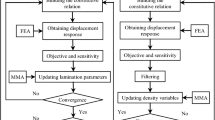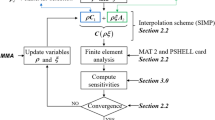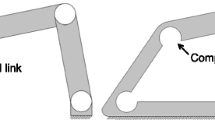Abstract
To improve the small deformation and high stress level in hinge zones of compliant mechanisms with isotropic material, a topology optimization method of compliant mechanisms with composite laminated plates was proposed. Based on the anisotropy and designability of composite laminated plates, a topology optimization model of compliant mechanisms with composite laminated plates was built to maximize the deformable capability. Numerical examples of designing compliant inverters and grippers were investigated to demonstrate the effectiveness of the proposed method. The influence mechanism of layer sequences on topologic shapes, deformation and loading capability were also discussed. The results showed that the deformable capability and stress levels of compliant mechanisms with composite laminated plates were further improved by a reasonable configuration of layer sequences.
Similar content being viewed by others
References
K. Lu and S. Kota, Design of compliant mechanisms for morphing structural shapes, J. of Intelligent Material Systems and Structures, 14 (6) (2003) 379–391.
K. Lu and S. Kota, An effective method of synthesizing compliant adaptive structures using load path representation, J. of Intelligent Material Systems and Structures, 16 (2) (2005) 307–317.
M. E. Aguirre and M. Frecker, Design and optimization of hybrid compliant narrow–gauge surgical forceps, Proceedings of the Conference on Adaptive Structures and Intelligent Systems, Philadelphia, Pennsylvania, USA (2010) 779–788.
M. Santer and S. Pellegrino, Topological optimization of compliant adaptive wing structure, AIAA J., 47 (3) (2009) 523–534.
A. Gaspari and S. Ricci, A two–level approach for the optimal design of morphing wings based on compliant structures, J. of Intelligent Material Systems and Structures, 22 (10) (2011) 1091–1111.
H. Panganiban, G. Jang and T. Chung, Topology optimization of pressure–actuated compliant mechanisms, Finite Elements Analysis and Design, 46 (3) (2010) 238–246.
C. S. Andreasen, A. R. Gersborg and O. Sigmund, Topology optimization of microfluidic mixers, International J. for Numerical Methods in Fluids, 61 (5) (2009) 498–513.
L. Yin and G. K. Ananthasuresh, Topology optimization of compliant mechanisms with multiple materials using a peak function material interpolation scheme, J. of Structural and Multidisciplinary Optimization, 23 (1) (2001) 49–62.
O. Sigmund, A 99 line topology optimization code written in matlab, J. of Structural and Multidisciplinary Optimization, 21 (2) (2001) 120–127.
C. B. W. Pedersen, T. Buhl and O. Sigmund, Topology synthesis of large–displacement compliant mechanisms, International J. for Numerical Methods Engineering, 50 (12) (2001) 2683–705.
Y. Wang, Z. Luo, Z. Kang and N. Zhang, A multi–material level set–based topology and shape optimization method, Computer Methods in Applied Mechanics and Engineering, 283 (2015) 1570–1586.
Z. Luo, N. Zhang and T. Wu, Design of compliant mechanisms using meshless level set methods, Computer Modeling in Engineering & Sciences, 85 (4) (2012) 299–328.
K. S. Yoo and S. Y. Han, Topology optimum design of compliant mechanisms using modified ant colony optimization, J. of Mechanical Science and Technology, 29 (8) (2015) 3321–3327.
J. Hur, P. Kang and S. K. Youn, Topology optimization based on spline–based meshfree method using topological derivatives, J. of Mechanical Science and Technology, 31 (5) (2017) 2423–2431.
A. T. Gaynor, N. A. Meisel, C. B. Williams and J. K. Guest, Multiple–material topology optimization of compliant mechanisms created via polyjet three–dimensional printing, J. of Manufacturing Science and Engineering–Transactions of the ASME, 136 (6) (2014) 0610151–10.
L. Ren, R. Yang, D. H. Mi and D. M. Guo, Topology optimization design for micro compliant mechanism with two materials, Proceedings of the ICMIT 2005: Control Systems and Robotics, Chongqing, China (2005) 60424–6.
D. M. Li, X. M. Zhang, Y. S. Guan and H. Zhang, Topology optimization of compliant mechanisms with anisotropic composite materials, Proceedings of the International Conference on Mechatronics and Automation, Xi’an, China (2010) 416–421.
X. X. Tong, W. J. Ge, C. Sun and X. Y. Liu, Topology optimization of compliant adaptive wing leading edge with composite materials, J. of Aeronautics, 27 (6) (2014) 1488–1494.
Z. S. Xu, Q. B. Huang and Z. G. Zhao, Topology optimization of composite material plate with respect to sound radiation, Engineering Analysis with Boundary Elements, 35 (1) (2011) 61–67.
M. Y. Wang, S. K. Chen, X. M. Wang and Y. L. Mei, Design of multimaterial compliant mechanisms using level–set methods, J. of Mechanical Design, 127 (5) (2005) 941–956.
S. Setoodeh, Combined topology and fiber path design of composite layers using cellular automata, J. of Structural and Multidisciplinary Optimization, 30 (6) (2005) 413–421.
A. Saxena and G. K. Ananthasuresh, On an optimal property of compliant topologies, J. of Structural and Multidisciplinary Optimization, 19 (1) (2000) 36–49.
Y. X. Wang, Mechanics and Structural Design of Composite Materials, East China University of Science and Technology press, Shanghai, China (2012).
Author information
Authors and Affiliations
Corresponding authors
Additional information
Recommended by Associate Editor Tae June Kang
Xinxing Tong received his Ph.D. from the Northwestern Polytechnical University. Now he is a researcher at the Xi’an University of Technology. His current research interest is topology optimization of compliant mechanism with composites materials.
Wenjie Ge is a Professor and Ph.D. advisor at the School of Mechanical Engineering, Northwestern Polytechnical University. His main research interests are theory of mechanism, topology optimization of compliant mechanism and Ricochet robots.
Rights and permissions
About this article
Cite this article
Tong, X., Ge, W., Zhang, Y. et al. Topology design and analysis of compliant mechanisms with composite laminated plates. J Mech Sci Technol 33, 613–620 (2019). https://doi.org/10.1007/s12206-019-0115-6
Received:
Revised:
Accepted:
Published:
Issue Date:
DOI: https://doi.org/10.1007/s12206-019-0115-6




